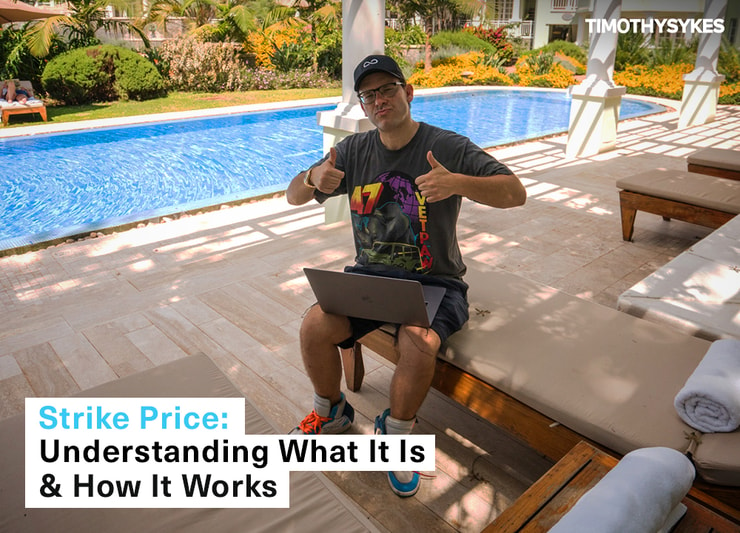Lately, we’ve been discussing options trading, and today I want to explain the strike price.
One of the basic components of options trading is the strike price. The strike price of an option contract forms the foundation for the rest of the trade. So it’s important to understand what a strike price is and how it’s different from other prices.
Options trading can get really complex. I don’t recommend it for newbies. Don’t try options trading until you master the basics. Learn to buy and sell stocks first. Then, if you want to, you can expand your horizons.
Full disclosure: I don’t trade options and I don’t teach options trading.
But I’m a firm believer in understanding different trading styles and the overall market. When you trade, it’s smart to have a basic understanding of how different parts of the market work — even options trading and strike prices … Let’s dig in.
Table of Contents
What Is a Strike Price?

A strike price is a potential stock price at some point in the future. There’s no guarantee that a stock will ever reach any strike price. When trading options, the strike price is where you think the price is headed in the future.
When you buy or sell an option, you have to determine the strike price at which you’re trading.
Let me give you a simple example. Say Company X is priced at $250, and I think the price will go up. I can buy a call option with a strike price of $255. When I purchase the option, I get just that: an option. I purchase the option to buy the stock for $255 even if the price goes to $275 or higher.
The strike price is a fundamental part of the options trade. You can’t trade options without a strike price … or there’s no way to price the contract against the current price.
Strike Price vs. Spot Price
A spot price is the last price the stock traded for. The spot price changes rapidly — especially when trading penny stocks.
When buyers and sellers agree on a price, that’s the spot price and the price at which the transaction goes through. Each spot price is often different from the previous and likely different from the next.
The spot price is always in the past. And the strike price is always in the future.
There’s no guarantee that the stock will ever hit the strike price. But a spot price has already happened. Every tick of the market represents a spot price that’s now in the past.
Strike Price vs. Stock Price
When most people refer to a stock price, they’re referring to the spot price we just reviewed.
Stocks actually have up to three different prices at any given moment. Depending on the stock and how fast it’s moving, these three prices can all be equal or all be different.
The spot price is a historical record of a price at which we know at least one buyer and one seller agreed on.
The bid and the ask present current offers to buy and sell. The bid is the current highest price a buyer is willing to pay. The ask is the current lowest price a seller is willing to sell for.
If the bid is $3 and the ask is $4, the $1 difference in the middle is known as the spread. (Hint: get to know market lingo — you can brush up here.)
In the example above, no buyer is forced to buy at $4 and no seller is forced to sell at $3. Once a buyer and a seller agree on a price — that might be $3.50 in this example — that’s the spot price.
None of these prices are the strike price … not the spot, the bid, or the ask. They can provide you with clues about where the price might go in the future, but the different stock prices are current offerings and historical records.
A strike price is in the future … maybe.
When trading options, you use the strike price to bet on future price moments. OK, now that you know what a strike price isn’t, let’s get into what it actually is.
How Strike Prices Work
The exchanges for options trading establish strike prices. The prices are determined by a set interval. I’ll dig into that more in a bit. Basically, strike prices give you a benchmark to bet against.
Different strike prices give you different odds. The further the strike price is from the spot price, the less likely the security will reach it.
Let’s go back to the example of Company X, which had a spot price of $250. We wanted to buy a call option with a strike price of $255. The chance of a $5 price increase isn’t that crazy, given enough time.
A strike price of $300 seems a little more far fetched. It’s not impossible, but $255 is more realistic than $300.
That’s why strike prices near the spot price are more expensive than strike prices that are farther from the spot price.
Strike Price Examples
Earlier we discussed a call option at a strike price of $255 when the underlying stock trades at $250.
Let’s say you expect the stock to go down instead of up. In this case, you could buy a put option. This allows you to profit if the stock price falls. If you buy a put option with a strike price of $245, you’re in the money if the stock hits any price below $245.
We also talked about buying options when you expect the price to move. But what if you think the price won’t change? You can sell options.
If the price doesn’t cross the strike price before the option expires, then the contract the buyer purchased is worthless. Ant the option seller keeps the entire premium.
Let’s look at an example and go back to Company X, which trades at $250. You think it will stay at this price for a while. You can sell put options with a strike price of $245 and call options with a strike price of $255. As long as the price stays between $245–$255, you keep all the premiums that buyers paid you.
But remember that if the price goes outside of that range, you’re obligated to buy or sell the stock at the strike price regardless of the current price.
How to Calculate a Strike Price
Traders who actually trade options don’t calculate strike prices. The exchanges actually determine strike prices. What we as traders can determine is the premium.
The option premium trades with a bid and an ask — just like stocks.
Use the strike price as input into options trading formulas. I won’t get into those here, but you can check out a few formulas from this recent post about trading options.
The strike price is an irreplaceable benchmark on which all other options calculations are based. You can select the strike price at which you want to place your bets, but you can’t determine or calculate the strike price.
More Breaking News
- Rezolve AI Continues to Shine Through Strategic Partnerships: What Lies Ahead?
- Can Vaxcyte Inc. Maintain Its Momentum After Recent Surge?
- Quantum Computing Inc. Faces Stock Decline: To Buy the Dip or Hold Back?
Strike Price Intervals
The intervals between strike prices are also out of your control. The exchanges determine the intervals.
These can vary depending on volume and the underlying price. Typically, the lower the price of the underlying stock, the smaller the interval.
As of this writing, Chesapeake Energy Corporation (CHK) trades for less than $1 per share and has options available at intervals of 50 cents.
Amazon.com, Inc. (AMZN) trades near $1,790 and has intervals of $2.50. AMZN is heavily traded and has very liquid options.
Credit Acceptance Corporation (CACC) isn’t as liquid. At the time of this writing, it trades around $440 with an interval of $10 for its options.
From these examples, you can tell there’s no set guide to determining strike price intervals. If you’re curious about a particular stock, look it up with your brokerage. Go to the options and view the straddle chart. This will show you every available strike price for trading options.
What Happens When an Option Hits the Strike Price?
The buyers and sellers change sides. Those who were in the money are now out, and those who were out of the money are now in the money.
Being in or out of the money doesn’t address actual profit or loss. To determine that, you gotta factor in the premium. But let’s start with the basics.
I’ll assume you know the basics of buying and selling options and how to calculate an option’s profit and loss.
If you’re not that familiar with these concepts, that’s OK. Don’t start trading options yet. Focus on your education. If you’re new to the markets, start here.
In the first example we discussed, we considered buying a call option for $255 when the spot price was $250. If the price goes to $257, we’re in the money. But if we paid a $5 premium for that option, we’re still in a losing trade.
Whoever sold us that option would move from in the money when the price was below $255 to out of the money once the price ticks above $255. They can still turn a profit until the price rises more than the premium they received. In this case, the price needs to hit $260.
Until the security hits the strike price and if the price stays below $255, the sellers typically do nothing. They hope the option expires worthless so they can keep the entire premium. As the buyers, if the stock doesn’t meet the strike price, our options contract expires worthless. We lose the $5 premium.
Once the stock meets the strike price, both buyers and sellers have to make some decisions.
As a seller, you can buy another option to cover your position and get out. You’re essentially cutting your losses or locking in whatever profit is left.
As a buyer, you must decide when to exercise your option and take advantage of your profit or limit your loss.
How to Set a Strike Price of an Option
As I already discussed, the exchanges set the strike prices based on the underlying price and demand for options.
As an options trader, you select the strike price you want to trade based on risk, reward, and liquidity. I don’t trade options, so I can’t even tell you where to start making these decisions.
Determining the right option to buy and sell is up to the individual trader. How to choose a strike price for call options or put options depends on each trader’s unique plan.
I trade penny stocks and can absolutely help you learn how to find trading opportunities for lower-priced stocks. My comprehensive Trader Checklist gives you a framework to help you decide if a trade is right for you.
Can You Sell an Option Before the Strike Price Is Met?
The short answer? Yes. You can freely trade options as much as you want on either side of the strike price. You can sell options before the strike price is met, after it’s met, or even at the strike price.
The long answer: it’s complicated. As I mentioned earlier, most basic strategies would dictate that buyers and sellers hold until the strike price is met.
As a general rule, options lose value as time goes on. The less time a stock has to move the less likely it is to make a move. In options trading, that’s known as “time decay.”
Given that an option’s value decays as time goes on, there’s typically no incentive to sell before the strike price is met. Typically, the option you bought is worth less than when you purchased it. As long as the strike price isn’t met.
But there are more options trading strategies than I can count. So I can’t rule out a strategy that does include buying and selling before the strike price is met.
Conclusion

Options trading is a way to bet on an underlying stock’s future moves, without actually buying the stock. The strike price is a key piece of options trading.
To place trades, you need a reference point — that’s the strike price. The strike price is a level of organization to a complex world.
I don’t recommend options to anyone. It’s outside of my expertise. And I definitely caution beginners from starting in options. The cost can be high, and this can be a highly complex and confusing trading strategy.
Not that any kind of trading is easy … Everything in the markets comes with risk. Penny stocks are what work for me. I do well in this niche, and I also have 20 years of experience. I think it’s great for traders with small accounts.
No matter what you trade, you need to study, work hard, and dedicate yourself to learning the process. Check out my introduction to penny stocks here.
Ready to take your trading to the next level? Apply to join my Trading Challenge and start on your journey to becoming a smart, self-sufficient trader today.
What do you think of this post? Share your thoughts in the comments below!



Leave a reply